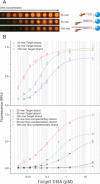Quantitative analysis of nucleic Acid hybridization on magnetic particles and quantum dot-based probes
- PMID: 22346716
- PMCID: PMC3274159
- DOI: 10.3390/s90705590
Quantitative analysis of nucleic Acid hybridization on magnetic particles and quantum dot-based probes
Abstract
In the present study we describe sandwich design hybridization probes consisting of magnetic particles (MP) and quantum dots (QD) with target DNA, and their application in the detection of avian influenza virus (H5N1) sequences. Hybridization of 25-, 40-, and 100-mer target DNA with both probes was analyzed and quantified by flow cytometry and fluorescence microscopy on the scale of single particles. The following steps were used in the assay: (i) target selection by MP probes and (ii) target detection by QD probes. Hybridization efficiency between MP conjugated probes and target DNA hybrids was controlled by a fluorescent dye specific for nucleic acids. Fluorescence was detected by flow cytometry to distinguish differences in oligo sequences as short as 25-mer capturing in target DNA and by gel-electrophoresis in the case of QD probes. This report shows that effective manipulation and control of micro- and nanoparticles in hybridization assays is possible.
Keywords: DNA; flow cytometry; fluorescence microscopy; hybridization; magnetic particles; quantum dots.
Figures




Similar articles
-
Specific nucleic acid detection using photophysical properties of quantum dot probes.Anal Chem. 2010 Feb 1;82(3):886-91. doi: 10.1021/ac902039n. Anal Chem. 2010. PMID: 20041684
-
Nucleic acid sandwich hybridization assay with quantum dot-induced fluorescence resonance energy transfer for pathogen detection.Sensors (Basel). 2012 Dec 4;12(12):16660-72. doi: 10.3390/s121216660. Sensors (Basel). 2012. PMID: 23211753 Free PMC article.
-
Flow cytometric detection of Bacillus spoOA gene in biofilm using quantum dot labeling.Anal Chem. 2010 Apr 1;82(7):2836-43. doi: 10.1021/ac902807n. Anal Chem. 2010. PMID: 20232819
-
Real-time assays with molecular beacons and other fluorescent nucleic acid hybridization probes.Clin Chim Acta. 2006 Jan;363(1-2):48-60. doi: 10.1016/j.cccn.2005.04.037. Epub 2005 Aug 18. Clin Chim Acta. 2006. PMID: 16111667 Review.
-
Selection of fluorophore and quencher pairs for fluorescent nucleic acid hybridization probes.Methods Mol Biol. 2006;335:3-16. doi: 10.1385/1-59745-069-3:3. Methods Mol Biol. 2006. PMID: 16785616 Review.
Cited by
-
Advanced nanotechnologies in avian influenza: Current status and future trends - A review.Anal Chim Acta. 2017 Aug 29;983:42-53. doi: 10.1016/j.aca.2017.06.045. Epub 2017 Jul 7. Anal Chim Acta. 2017. PMID: 28811028 Free PMC article. Review.
References
-
- Katz E., Willner I. Integrated nanoparticle-biomolecule hybrid systems: synthesis, properties, and applications. Angew. Chem. Int. Ed. 2004;43:6042–6108. - PubMed
-
- Elghanian R., Storhoff J.J., Mucic R.C., Letsinger R.L., Mirkin C.A. Selective colorimetric detection of polynucleotides based on the distance-dependent optical properties of gold nanoparticles. Science. 1997;277:1078–1081. - PubMed
-
- Ahmed A.R., Olivier G.W., Adams G., Erskine M.E., Kinsman R.G., Branch S.K., Moss S.H., Notarianni L.J., Pouton C.W. Isolation and partial purification of a melanocyte-stimulating hormone receptor from B16 murine melanoma cells: a novel approach using a cleavable biotinylated photoactivated ligand and streptavidin-coated magnetic beads. Biochem. J. 1992;286:377–382. - PMC - PubMed
-
- Ossendorp F.A., Bruning P.F., van den Brink J.A., de Boer M. Efficient selection of high affinity B cell hybridomas using antigen-coated magnetic beads. J. Immunol. Methods. 1989;120:191–200. - PubMed
LinkOut - more resources
Full Text Sources
Other Literature Sources
Miscellaneous

